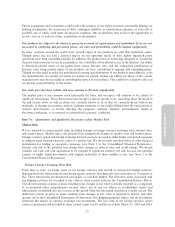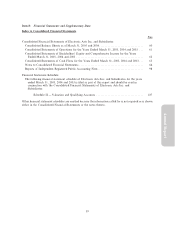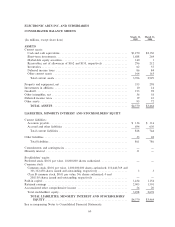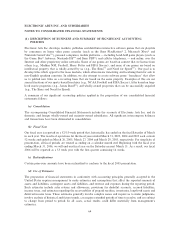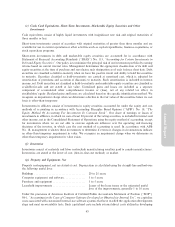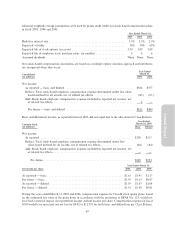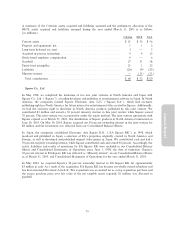Electronic Arts 2005 Annual Report Download - page 121
Download and view the complete annual report
Please find page 121 of the 2005 Electronic Arts annual report below. You can navigate through the pages in the report by either clicking on the pages listed below, or by using the keyword search tool below to find specific information within the annual report.
(e) Cash, Cash Equivalents, Short-Term Investments, Marketable Equity Securities and Other
Investments
Cash equivalents consist of highly liquid investments with insigniÑcant rate risk and original maturities of
three months or less.
Short-term investments consist of securities with original maturities of greater than three months and are
available for use in current operations or other activities such as capital expenditures, business acquisitions, or
stock repurchase programs.
Short-term investments in debt and marketable equity securities are accounted for in accordance with
Statement of Financial Accounting Standards (""SFAS'') No. 115, ""Accounting for Certain Investments in
Debt and Equity Securities''. Our policy is to minimize the principal risk of our investment portfolio by earning
returns based on current interest rates. Management determines the appropriate classiÑcation of its debt and
equity securities at the time of purchase and reevaluates such designation as of each balance sheet date. Debt
securities are classiÑed as held-to-maturity when we have the positive intent and ability to hold the securities
to maturity. Securities classiÑed as held-to-maturity are carried at amortized cost, which is adjusted for
amortization of premiums and accretion of discounts to maturity. Such amortization is included in interest
income, net. Debt securities not classiÑed as held-to-maturity and marketable equity securities are classiÑed as
available-for-sale and are stated at fair value. Unrealized gains and losses are included as a separate
component of accumulated other comprehensive income or (loss), net of any related tax eÅect, in
stockholders' equity. Realized gains and losses are calculated based on the speciÑc identiÑcation method. We
recognize an impairment charge when we determine a decline in the fair value of the securities below its cost
basis is other-than-temporary.
Investments in aÇliates consist of investments in equity securities accounted for under the equity and cost
methods of accounting in accordance with Accounting Principles Board Opinion (""APB'') No. 18, ""The
Equity Method Of Accounting For Investments In Common Stock''. Our share of earnings or losses of
investments in aÇliates, in which we own at least 20 percent of the voting securities, is included in interest and
other income, net in the Consolidated Statement of Operations using the equity method of accounting, except
for investments where we are not able to exercise signiÑcant inÖuence over the operating and Ñnancing
decisions of the investee, in which case the cost method of accounting is used. In accordance with APB
No. 18, management evaluates these investments to determine if events or changes in circumstances indicate
an other-than-temporary impairment in value. We recognize an impairment charge when we determine an
other-than-temporary impairment in value exists.
(f) Inventories
Annual Report
Inventories consist of materials and labor and include manufacturing royalties paid to console manufacturers.
Inventories are stated at the lower of cost (Ñrst-in, Ñrst-out method) or market.
(g) Property and Equipment, Net
Property and equipment, net are stated at cost. Depreciation is calculated using the straight-line method over
the following useful lives:
Buildings ÏÏÏÏÏÏÏÏÏÏÏÏÏÏÏÏÏÏÏÏÏÏÏÏÏÏÏÏÏÏÏÏÏÏÏÏ 20 to 25 years
Computer equipment and software ÏÏÏÏÏÏÏÏÏÏÏÏÏÏÏ 3 to 5 years
Furniture and equipment ÏÏÏÏÏÏÏÏÏÏÏÏÏÏÏÏÏÏÏÏÏÏÏ 3 to 5 years
Leasehold improvements ÏÏÏÏÏÏÏÏÏÏÏÏÏÏÏÏÏÏÏÏÏÏÏ Lesser of the lease terms or the estimated useful
lives of the improvements, generally 1 to 10 years
Under the provisions of American Institute of CertiÑed Public Accountants Statement of Position (""SOP'')
98-1, ""Accounting for the Costs of Computer Software Developed or Obtained for Internal Use'', we capitalize
costs associated with customized internal-use software systems that have reached the application development
stage and meet recoverability tests. Such capitalized costs include external direct costs utilized in developing
65


